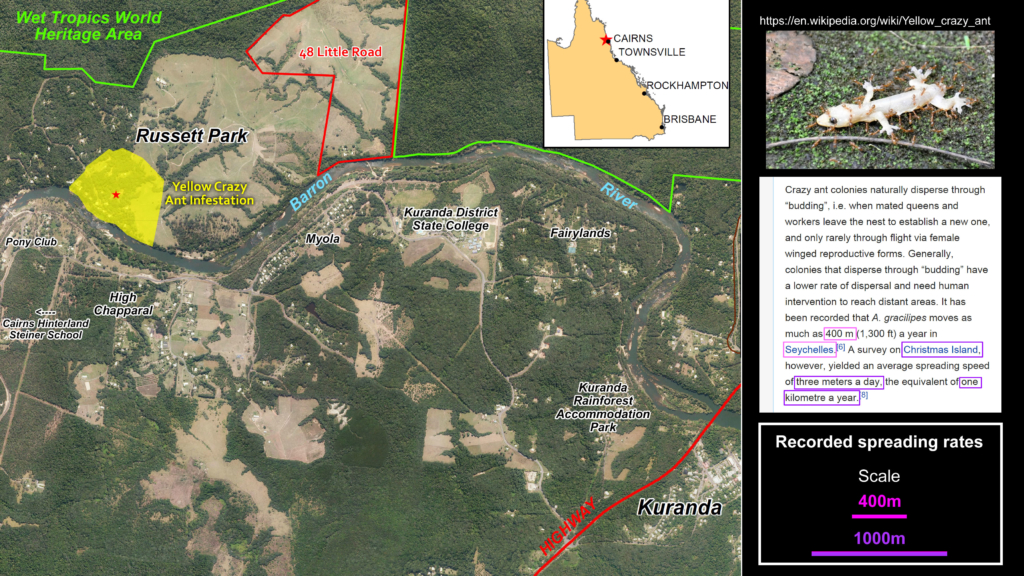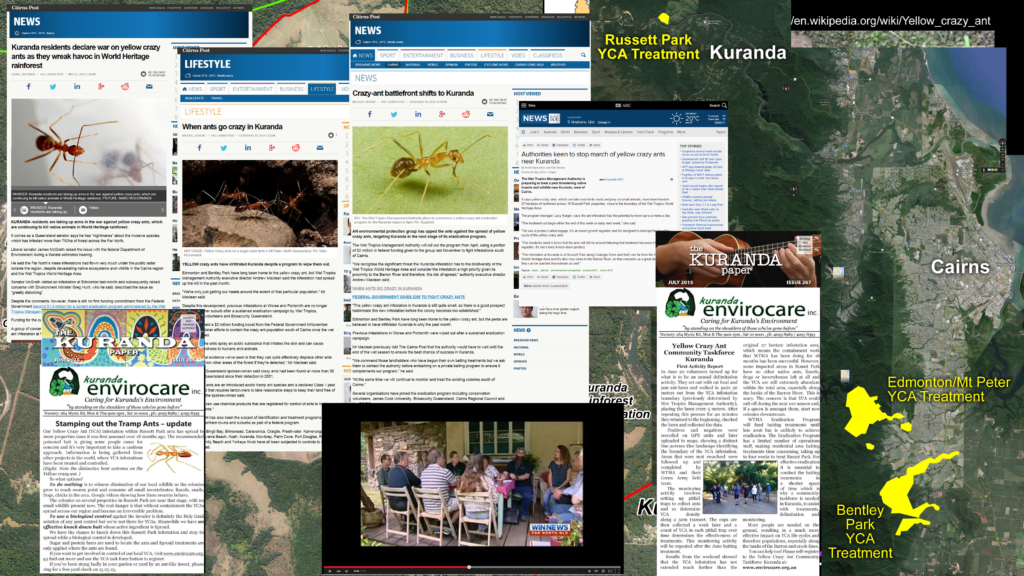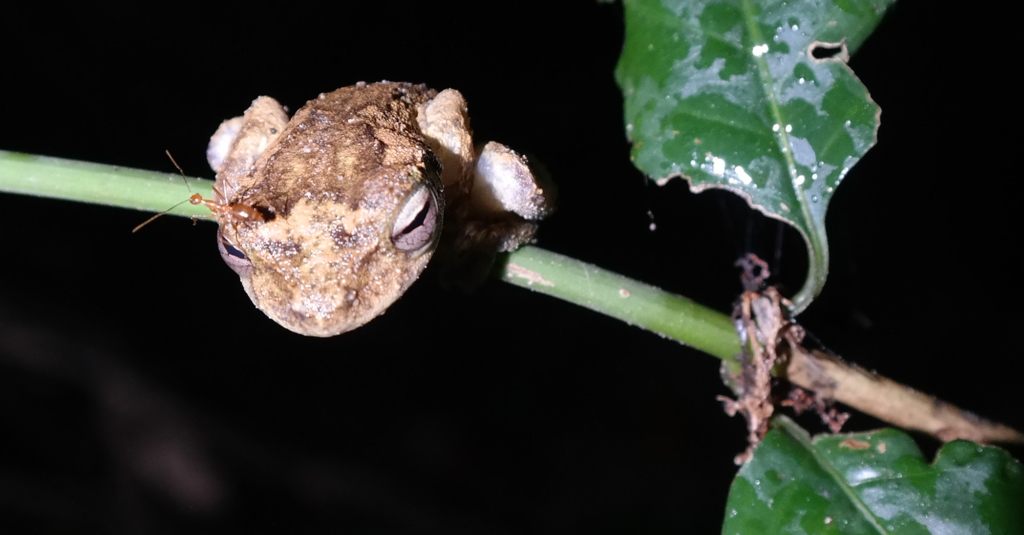TO: Ken Lee
CC: Colliers International – Stacey Quaid, Dan Brown
Mareeba Shire Council
KUR-World / KUR-Cow – Ken Lee, Mark Lawson, Simon Danielsen
Bulwai Cultural Custodian – Willie Brim
Web version: http://kurandaregion.org/48-little-road-kuranda-qld-4881/
Property link: http://www.realestate.com.au/property-livestock-qld-kuranda-7826542
Dear Ken Lee,
It has come to our attention that the cattle property at 48 Little Road Kuranda Qld 4881 came ‘under contract’ earlier this month.
As the buyer is confidential until such time as the property is settled, we felt an urgent need to advise you of several issues pertaining to this property, in the event that you, or Reever and Ocean Pty Ltd, are the buyer.
- Yellow Crazy Ant Infestation on Northern side of Barron River, Russett Park.
It is a clear and unnecessary biosecurity threat to have unmitigated vehicle movements across the Barron river from a declared YCA Infestation Area. Introducing NEW cattle truck movements to support an intensive cattle operation from the YCA infested side of the Barron River to Barnwell, and transporting to Tablelands cattle properties poses far too great a threat to spreading this so-far-unstoppable invasive species.
Radically different to the extensive cattle businesses on the Tablelands, the Kuranda Region grazing lands are small family lifestyle run businesses… mostly on historically zoned rural titles nestled in the rainforest corridor. Our community does not believe intensive cattle grazing is a suitable land use for rainforest land adjacent the World Heritage Wet Tropics Area and World Heritage Great Barrier Reef. This land is not the same value as the traditional cattle grazing land out west.
Please see ATTACHMENT maps of infestation areas provided.
- Intensive Cattle Grazing in Kuranda
Historically the Kuranda Region, including the Barnwell 12 Rural Titles and other cleared cattle grazing titles, were NEVER RUN as intensive cattle operations.
“Under the Wet Tropics Management Plan 1998 goats, deer and cattle are classified as ‘undesirable animals’ and are prohibited within the Wet Tropics World Heritage Area.” http://www.wettropics.gov.au/site/user-assets/docs/policy10_grazing.pdf
While I understand your defence may be that your property isn’t on the ‘official’ Wet Tropics area formally recognised in 1988, I will argue the forest doesn’t recognise the lines drawn up by the map-maker and that ‘wildlife corridors’ are not thin veneers of remnant forest.
If you are planning to develop an intensive cattle operation in our region – you will need to pause – and provide the following please:
a) What water allocation you are proposing to remove from the local water supply and ecosystems for your cattle operation/s?
b) Provide the product names of the agricultural chemicals you will be using for:
- improving pasture, ie. fertilizers, weed controls
- cattle drenching, and other cattle medications
- [any others? Insert here]
c) For Barnwell, provide your Water Quality Testing Procedure for year on year testing – including baseline tests to be provided asap.
- The Kuranda Town Water inlet is 500m downstream from the Barnwell property, thereby escalating the opportunity for water-borne bacteria and virus’ to enter the water supply of 2000+ residents.
- Immediate adjacent properties draw a water allocation from creeks immediately leaving Barnwell property.
Please provide a guarantee the water quality will not be altered leaving your property. Residents demand no net change to rainforest creeks and the Barron River town water supply.
d) Wildlife fencing – please see ATTACHMENT below
e) Concerns for significantly increased Myola Road traffic movements of infrastructure, heavy agricultural machinery and cattle trucks. This will impact on the peace of your neighbours.
Our community is challenged with the notion that an individual landholder, such as yourself, with the opportunity to purchase cheap rural land (approx. $1300/acre) now has any authority to stamp KUR-World, KUR-Cow or the next intensive KUR-Development.
With all due respects Ken Lee – you purchased cheap rural land as a person. Setting up a legal entity to develop this land for maximum profit is not appropriate land use. The land you have purchased is among only 3% of precious land (remaining) that is triggered as ecologically significant in Queensland.
Mega-tons of concrete, helicopters, 4000 people, domestic cats and dogs, massive traffic movements, stormwater run-off, intensive cattle operation with hard hooves, cowshit and chemicals are the last things this innocent land, water and its creatures need.
How do you figure this land owes you anything at all?
Why do you think it is your right to impose your will so recklessly on this Vital Kuranda Envirolink Corridor land and the communities who call this place home?
No amount of profit is worth what will be lost in this place.
I look forward to your reply regarding our concerns, as above.
Kind regards,
jo
ATTACHMENTS:
VIDEO: August 2015 – Yellow Crazy Ants – Russett Park Infestation – https://www.youtube.com/watch?v=2yqze6GJiGI
Wildlife fencing
—————————–
Max Chappell via email
Manager Planning and Conservation
Wet Tropics Management Authority
Regarding your request for advice on wildlife-friendly fencing for cattle.
For your info, there was a WWF project in 2007 regarding wildlife-friendly fencing. Refer here. Note the involvement of the Tolga Bat Hospital in this project. However, I can’t find any findings from the proposed trials. It looks like one of the outcomes was to set up a website about wildlife friendly fencing – refer http://www.wildlifefriendlyfencing.com/WFF/Home.html
The fencing guidelines on this site primarily comes from a 1994/95/96 publication of the Kondinin Group called “Wires and Pliers’. The information is based on a 1993 survey of 3879 farmers by the Kondinin Group though Farming Ahead and Wool News.
The publication states there have been no studies on the relative wildlife-friendliness of different types of fencing, though from experience we do know:
1. 86% of wildlife entangled on barbed wire are caught on the top strand.
2. Fences that are new, on ridge lines, near feeding trees, or over water are more often reported as entangling bats.
Speaking to my colleagues, they advise the top strand of barbed wire is renown for impacting wildlife. However, if the cattle aren’t well domesticated, and tend to be wild in nature, they will tend to lean over and push the fence down (unless a higher fence is constructed so they can’t get heads over or through – but this increases the cost of fencing significantly). WTMA’s preferred option is electric fencing with docile stock.
——————————-



